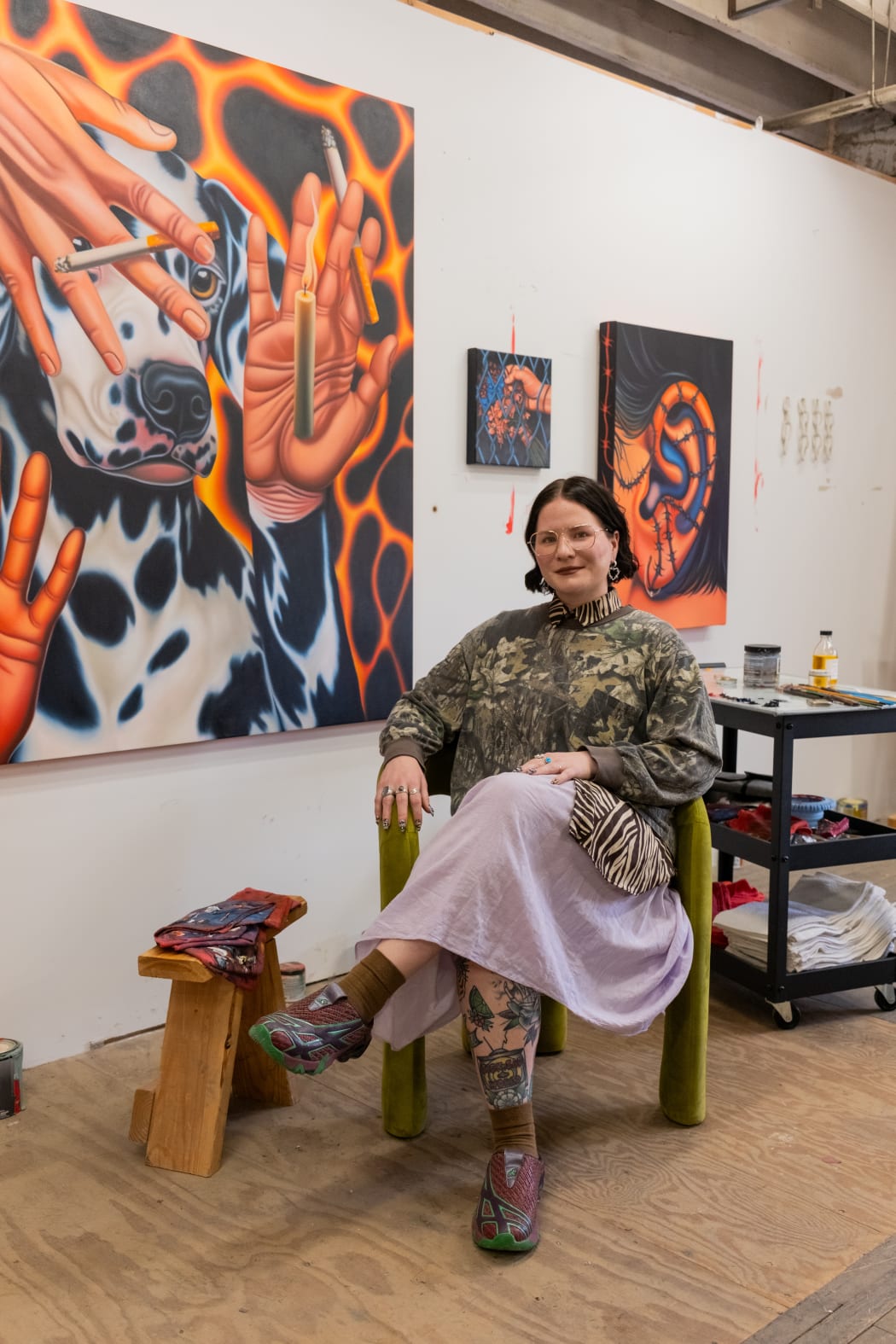
What if We Don't Get Older
On view: July 12th - August 16th, 2025
5103 W. Adams, Los Angeles
Good Mother Gallery is pleased to present What if We Don’t Get Older, a solo exhibition by Madeline Brice. Based in Kansas City, Missouri, Brice is known for her psychologically charged paintings that delve into the chaotic beauty of human neurosis. Her latest body of work explores themes of mortality, identity, suppressed desires, and the false narratives we construct to survive. In a series of vivid, dreamlike compositions, Brice invites viewers into fractured landscapes where domestic symbols collide with existential dread.
We interviewed Madeline about her current exhibition below:
GM: Let’s start with the show title, What if We Don’t Get Older. There's a sense of denial, fear, or even fantasy in the title. Where did this phrase come from, and what possibilities does it open up for you?
MADELINE BRICE: With marriage and with age I’ve been thinking a lot about what the future might look like. Usually there’s intent to grow old with the one that you marry, but what if you don’t? For the first time in my life I’ve been grappling with mortality, intrusive thoughts, and the realization that I might not get old, even if I wanted to. I’ve been very lucky to have been a mere bystander to death, having never lost anyone incredibly close, and I fear for the day that happens, because it’s inevitable, and what if I’m not equipped to cope?
I’ve also been thinking a lot about memories and how fleeting they feel. I often think I have no memory, but something sparks a spiral and suddenly I’m there. Memories feel so strange, so foreign to me. I think in a way my paintings exemplify what memories feel like to me
GM: Could you discuss one artwork in the exhibition that completely informed the rest of the body of work?
MADELINE BRICE: I started with ‘vanishing into nothingness the second this ends’. It’s the largest piece I’ve made to date and I knew I needed to give myself plenty of time to respond to the composition. I worked on it for about 4 months while developing the rest of the work.
I think this piece uniquely inspired the others in that I set out to capture a very specific but blurry memory of a midwest summer night after too many drinks. Many times my paintings are an amalgamation of a few memories, and this might be too, but I wanted to ensure that it felt specific yet uncertain. Dalmatians are historically associated with fighting fire and guardianship. I needed a guard and a guide as I dove deeper and deeper into my psyche.
GM: Your work has a very surreal tone to it, I feel the vortex-like background pays homage to that specific style of painting. How does the background of your pieces give insight to the foreground?
MADELINE BRICE: Well, I’m obsessed with Ed Paschke’s portraiture, specifically his work from the 70s. I think the influence is obvious if you’re familiar with his work. I love how he created these insanely trippy, unreal worlds for the figures to live within. They never felt like a space that existed in actuality, but then again the figures really didn’t either.
I’m drawn to a visual and perceptive dissonance within my compositions. The perspective never really makes sense if you dive into it. I love this sort of forced intimacy with the closeness (and somehow flatness) of the subject matter, but everything is disembodied still, leaving you wondering what might be happening just outside the confines of the canvas. I also love to play with perspective, making small things big, and big things small. For me, this is a literal visual representation of how my brain recalls memories and how my own perception shapes my reality.
GM: How would you describe the process at arriving at the themes of these paintings?
MADELINE BRICE: My work never seems to be influenced or inspired by just one thing. I tend to pull a lot of different ideas, feelings, memories, into one composition to create an entirely new world. A lot of times these ideas stem from journaling and free writing exercises, books I’m reading, and general digital consumption. The worlds would never exist in the real, but I guess they maybe could.
The theme is always evolving and is never one thing because that’s generally how I feel about existence. The root of my practice is that the act of painting must be fun. I create compositions that I know would produce an exciting experience to paint. If it isn’t fun I usually abandon it.
GM: Do you think about storytelling when you paint? Or are these more an open-ended map into your own psychology/world?
MADELINE BRICE: I don’t tend to think about storytelling when I paint. For me, the storytelling comes after, when I’ve had some time to sit with the work. In the midst of creating I’m not thinking about how one work connects to another per se, but in the end it all seems to come together into a bigger picture. Each piece is its own moment in time, past, present, or future. And they’re related (maybe) because they were made in the same time period with the same thoughts circling my head, but also maybe not.
